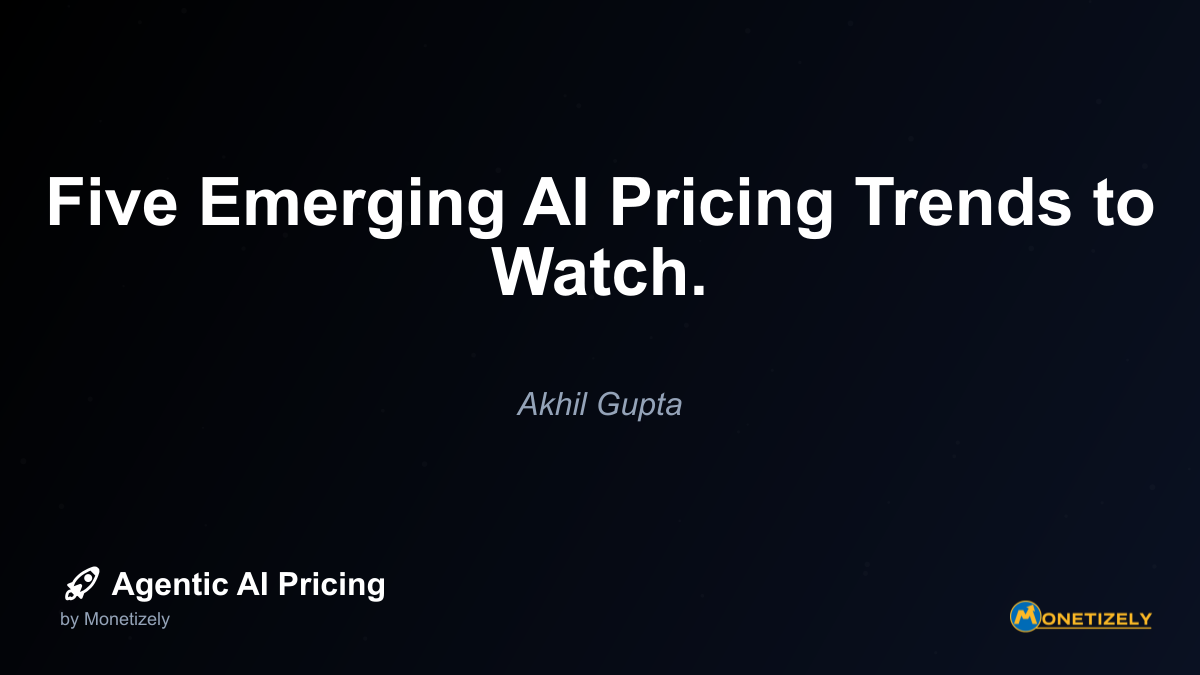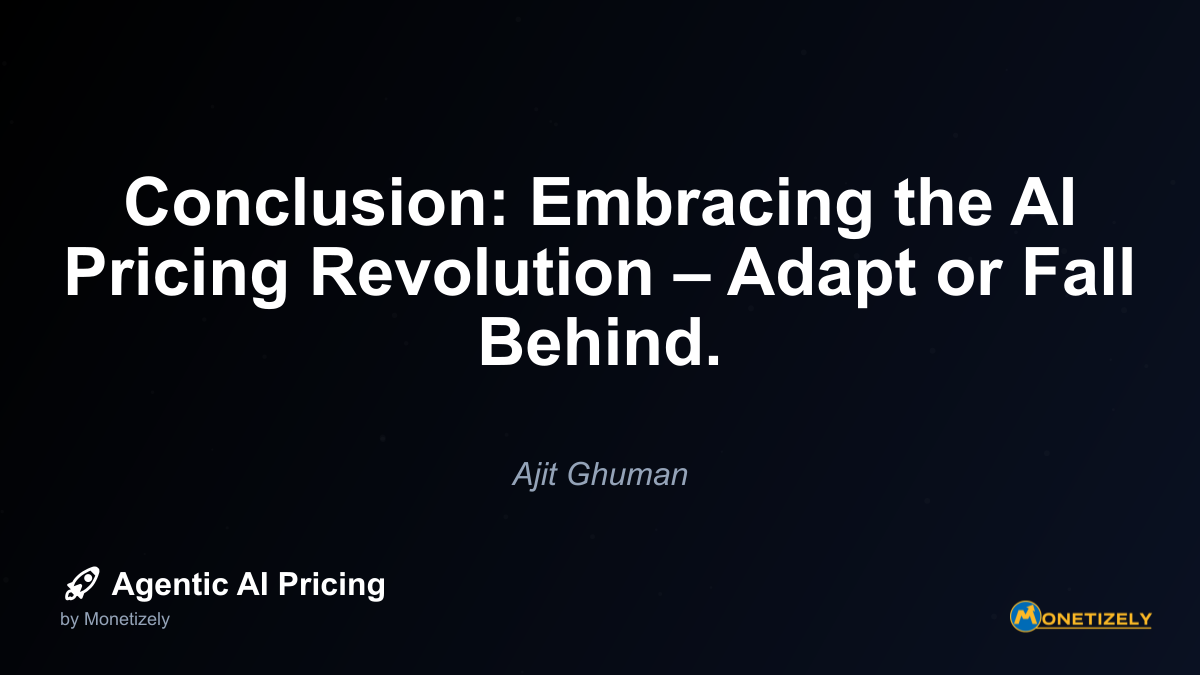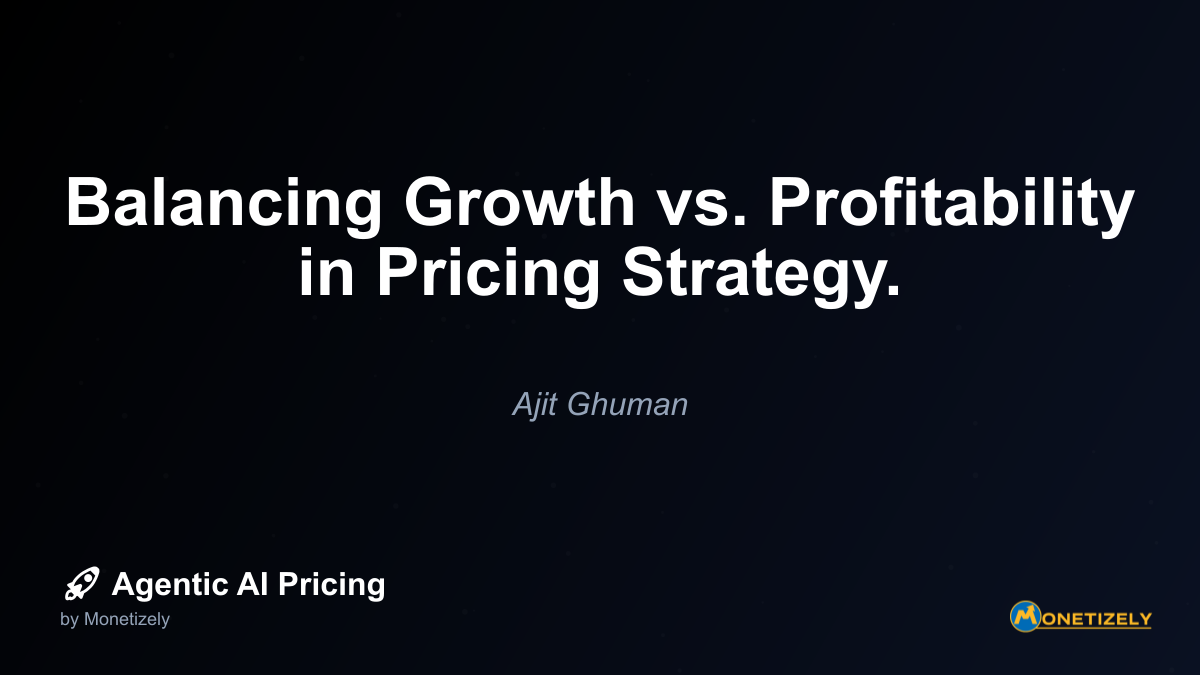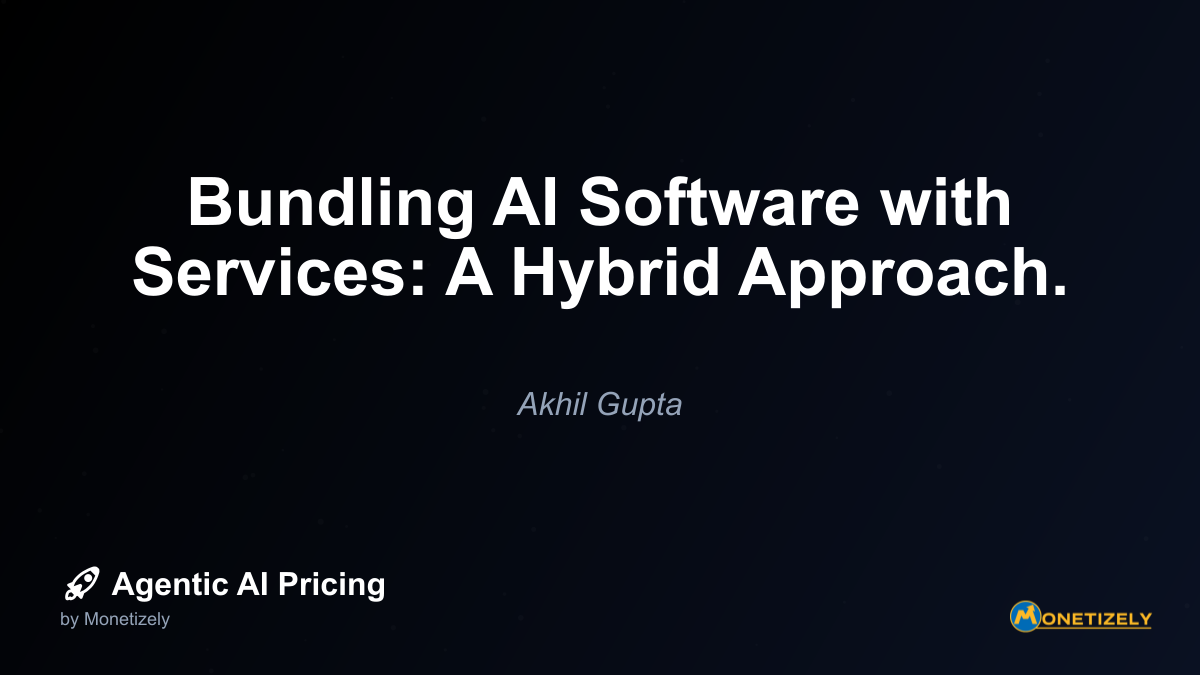· Akhil Gupta · Strategy & Planning · 7 min read
Five Emerging AI Pricing Trends to Watch.
AI and SaaS Pricing Masterclass
Learn the art of strategic pricing directly from industry experts. Our comprehensive course provides frameworks and methodologies for optimizing your pricing strategy in the evolving AI landscape. Earn a professional certification that can be imported directly to your LinkedIn profile.

4. The Shift from Subscription to Dynamic Usage-Based Models
While subscription models have dominated the SaaS landscape for years, AI solutions are increasingly moving toward more dynamic usage-based pricing approaches. This shift reflects the variable nature of AI utilization and the difficulty of predicting resource consumption in advance.
Usage-based AI pricing models offer several advantages over traditional subscriptions, particularly for technologies where usage patterns may be unpredictable or vary significantly across time periods. This approach is becoming the dominant paradigm for several reasons:
Resource consumption alignment: AI workloads can be highly variable and resource-intensive:
- Computational costs (especially for training or complex inference) can vary dramatically
- Storage requirements fluctuate based on data volume
- API call patterns may be inconsistent or seasonal
Granular visibility and control: Usage-based models provide:
- Detailed breakdowns of cost drivers
- Ability to set usage thresholds and alerts
- Transparency into which AI functions drive costs
- Options to optimize for cost-efficiency
Flexible scaling: Organizations benefit from:
- No artificial user or feature limitations
- Ability to start small and grow incrementally
- Cost scaling that matches value realization
- Reduced risk when experimenting with new AI capabilities
The implementation of usage-based pricing is becoming more sophisticated, with vendors offering:
Multi-dimensional metering: Pricing based on combinations of factors:
- Computation time or resources consumed
- Data volume processed
- Number and complexity of models used
- Quality or confidence levels requested
Predictable caps and guarantees: Features that provide cost certainty:
- Maximum monthly spend limits
- Volume discounts at higher usage tiers
- Reserved capacity options for predictable workloads
- Spend forecasting tools
Consumption optimization tools: Helping customers manage costs:
- Usage analytics dashboards
- Automated scaling and throttling options
- Cost allocation across departments or projects
- Recommendations for efficiency improvements
This trend is particularly evident in generative AI services, where the computational requirements can vary dramatically based on the complexity and volume of content being generated. Organizations are increasingly demanding pricing structures that reflect this variability while providing mechanisms for cost control and predictability.
5. Tiered Quality and Capability Differentiation
A significant emerging trend in AI pricing is differentiation based on quality levels, accuracy tiers, and capability depth. Rather than offering a single version of an AI service, providers are increasingly stratifying their offerings into distinct tiers with corresponding price points, allowing customers to select the performance level that matches their requirements and budget.
This approach recognizes that not all AI applications require the same level of sophistication, accuracy, or speed. For example, a draft-generation AI might be priced differently than one optimized for publication-ready content, or a real-time recommendation engine might command a premium over a batch processing alternative.
Key manifestations of this trend include:
Performance-tiered pricing: Models differentiated by quantifiable metrics:
- Accuracy levels (e.g., 85% vs. 95% vs. 99%)
- Response time guarantees (milliseconds vs. seconds)
- Throughput capacities (transactions per second)
- Model size and sophistication (parameters, training data volume)
Feature-based differentiation: Pricing aligned with capability depth:
- Basic, standard, and advanced feature sets
- Industry-specific optimizations as premium add-ons
- Specialized capabilities (e.g., multilingual support, multimodal processing)
- Integration options and customization capabilities
SLA-linked pricing: Costs tied to guaranteed service levels:
- Availability commitments (uptime percentages)
- Support response times
- Update frequency and model freshness
- Compliance and security certifications
This trend is particularly relevant for large language models and generative AI, where there are clear quality and capability differences between model generations and sizes. Customers can choose to pay premium prices for cutting-edge capabilities or opt for more economical options with acceptable performance for less demanding applications.
For businesses implementing AI, this tiered approach enables more precise matching of solutions to requirements, potentially reducing costs by avoiding over-purchasing capabilities. It also creates clearer upgrade paths as needs evolve or as the value of higher-quality AI becomes apparent through initial implementations.
How These Trends Are Reshaping AI Investment Decisions
These five pricing trends aren’t evolving in isolation—they’re interconnected and collectively transforming how organizations approach AI investment decisions. Understanding these relationships is crucial for developing effective AI pricing and purchasing strategies.
Balancing Flexibility and Predictability
The shift toward usage-based and performance-based models offers greater flexibility but can introduce budgeting challenges. Organizations are developing new approaches to balance these considerations:
Hybrid budgeting approaches: Combining elements of different models:
- Core capacity purchased through subscriptions
- Burst capacity available through usage-based pricing
- Performance bonuses for exceptional results
- Minimum commitments with variable components
Portfolio management: Diversifying across pricing models:
- Stable, mission-critical functions on predictable pricing
- Experimental or variable workloads on consumption-based models
- Strategic capabilities on performance-based arrangements
- Commodity functions sourced from marketplaces
Internal chargeback mechanisms: Developing systems to:
- Allocate AI costs to business units based on value derived
- Create internal markets for AI resource utilization
- Implement governance around high-cost AI functions
- Track ROI at the department or use-case level
Value-Based Decision Frameworks
The diversification of pricing models is driving organizations to develop more sophisticated frameworks for evaluating AI investments:
Total value of ownership: Looking beyond direct costs to consider:
- Implementation and integration requirements
- Ongoing management overhead
- Training and skill development needs
- Opportunity costs of delayed implementation
Risk-adjusted evaluation: Assessing pricing models based on:
- Alignment with confidence in outcomes
- Downside protection in case of underperformance
- Upside potential for exceptional results
- Flexibility to adapt as needs evolve
Strategic vs. commodity differentiation: Distinguishing between:
- Strategic AI capabilities that deliver competitive advantage
- Commodity functions where cost efficiency is paramount
- Experimental areas where flexible pricing reduces risk
- Core capabilities requiring predictable, controlled costs
Preparing Your Organization for the New AI Pricing Landscape
To navigate these evolving pricing trends effectively, organizations should consider several practical steps:
1. Develop AI-Specific Procurement Expertise
Traditional software procurement approaches are often inadequate for evaluating AI solutions and their pricing models. Organizations should:
- Create cross-functional teams including technical, business, and financial stakeholders
- Develop AI-specific evaluation criteria that account for quality and performance metrics
- Build competency in modeling usage patterns and consumption forecasting
- Establish benchmarks for comparing AI value across different pricing structures
2. Implement Robust Monitoring and Management
The variable nature of many AI pricing models requires more active management than traditional software licenses:
- Deploy tools for tracking AI usage, costs, and performance metrics
- Establish governance processes for approving high-cost AI operations
- Create feedback loops between AI utilization and business outcomes
- Develop optimization strategies for maximizing value per dollar spent
3. Adopt Portfolio Approaches to AI Pricing
Rather than seeking a one-size-fits-all approach, organizations should:
- Match pricing models to use cases based on value, criticality, and usage patterns
- Experiment with different models for new AI implementations
- Regularly review and optimize existing arrangements
- Consider the total landscape of AI investments when making individual decisions
4. Build Internal Value Measurement Capabilities
To effectively engage with performance-based pricing, organizations need:
- Clear methodologies for measuring AI-driven business outcomes
- Baseline data for before-and-after comparisons
- Attribution models for isolating AI contributions to results
- Negotiation frameworks for establishing fair value-sharing arrangements
The Future of AI Pricing: Beyond Current Trends
Looking further ahead, several emerging developments may shape the next wave of AI pricing innovation:
Ecosystem-Based Pricing
As AI becomes more interconnected, we may see pricing models that reflect ecosystem participation:
- Value distribution across data providers, model creators, and application developers
- Network-effect pricing where costs decrease as ecosystem participation grows
- Marketplace dynamics where algorithms compete on price-performance metrics
- Data contribution offsets where providing training data reduces service costs
Outcome Guarantees and Risk Transfer
The maturation of AI may lead to more definitive outcome guarantees:
- “Money-back” guarantees for specific performance thresholds
- Insurance-like products covering AI implementation risks
- Third-party validation and certification of AI performance claims
- Escrow arrangements for performance-based payments
Ethical and Responsible AI Premiums
As ethical considerations become more prominent, pricing may reflect:
- Premium tiers for demonstrably fair and unbiased models
- Transparency premiums for explainable AI
- Sustainability pricing reflecting environmental impact of model training and operation
- Compliance certifications built into pricing structures
Conclusion: Strategic Implications for Decision Makers
The evolution of AI pricing models reflects the maturing of the technology and market. For decision-makers, these trends present both opportunities and challenges that require thoughtful navigation.
Organizations that understand these pricing trends can:
- Align costs with value realization by selecting models that match their specific AI implementation goals
- Reduce financial risk through models that share outcomes or scale with demonstrated success
- Accelerate adoption by starting with lower-commitment options and scaling as value is proven
- Optimize resource allocation by matching pricing models to the strategic importance of different AI functions
- Create competitive advantage through more sophisticated approaches to AI investment evaluation
The diversification of AI pricing represents a positive development for the market, enabling more precise matching of costs to value and reducing barriers to adoption. However, it also demands greater sophistication from buyers in evaluating options and managing ongoing AI investments.
By staying informed about these trends and developing appropriate internal capabilities, organizations can navigate the evolving AI pricing landscape effectively, ensuring they extract maximum value from their AI investments while maintaining cost control and predictability.
As AI continues its rapid evolution, pricing models will undoubtedly continue to adapt. The organizations that thrive will be those that view AI pricing not merely as a procurement challenge but as a strategic consideration that directly impacts their ability to derive competitive advantage from these powerful technologies.
Co-Founder & COO
Akhil is an Engineering leader with over 16+ years of experience in building, managing and scaling web-scale, high throughput enterprise applications and teams. He has worked with and led technology teams at FabAlley, BuildSupply and Healthians. He is a graduate from Delhi College of Engineering and UC Berkeley certified CTO.
Pricing Strategy Audit
Let our experts analyze your current pricing strategy and identify opportunities for improvement. Our data-driven assessment will help you unlock untapped revenue potential and optimize your AI pricing approach.




